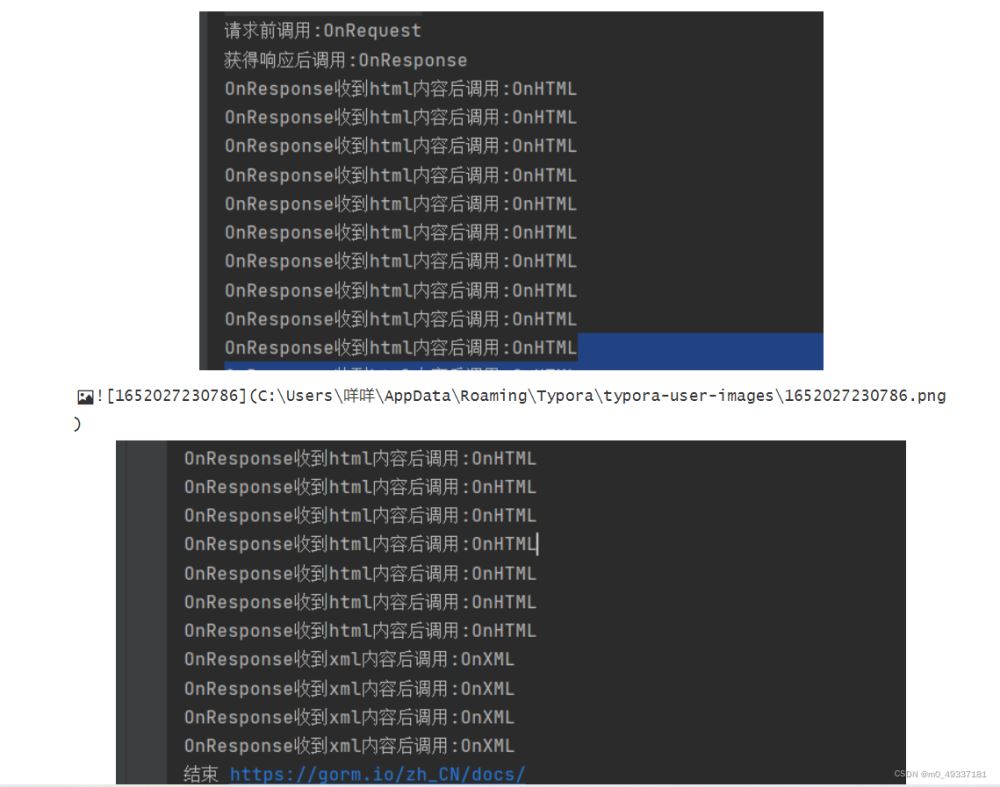Golang爬虫框架colly的使用
来源:脚本之家
时间:2022-12-25 07:53:26 427浏览 收藏
IT行业相对于一般传统行业,发展更新速度更快,一旦停止了学习,很快就会被行业所淘汰。所以我们需要踏踏实实的不断学习,精进自己的技术,尤其是初学者。今天golang学习网给大家整理了《Golang爬虫框架colly的使用》,聊聊colly,我们一起来看看吧!
Golang爬虫框架 colly 简介
colly是一个采用Go语言编写的Web爬虫框架,旨在提供一个能够些任何爬虫/采集器/蜘蛛的简介模板,通过Colly。你可以轻松的从网站提取结构化数据,然后进行数据挖掘,处理或归档
项目特性
- 清晰明了的API
- 速度快(每个内核上的请求数大于1K)
- 管理每个域的请求延迟和最大并发数
- 自动cookie和会话处理
- 同步/异步/ 并行抓取
- 高速缓存
- 自动处理非Unicode编码
- 支持Robots.txt
- 支持Google App Engine
- 通过环境变量进行配置
- 可拓展
安装colly
go get -u github.com/gocolly/colly
第一个colly 应用
package main
import (
"fmt"
"github.com/gocolly/colly"
)
func main() {
c := colly.NewCollector()
// goquery selector class
c.OnHTML(".sidebar_link", func(e *colly.HTMLElement) {
e.Request.Visit(e.Attr("href"))
/* link := e.Attr("href")
// Print link
fmt.Printf("Link found: %q -> %s\n", e.Text, link)
// Visit link found on page
// Only those links are visited which are in AllowedDomains
c.Visit(e.Request.AbsoluteURL(link))*/
})
c.OnRequest(func(r *colly.Request) {
fmt.Println("url:",r.URL)
})
c.Visit("https://gorm.io/zh_CN/docs/")
}
回调函数的调用顺序
- OnRequest 在请求之前调用
- OnError 如果请求期间发生错误,则调用
- OnResponseHeaders 在收到响应标头后调用
- OnResponse 收到回复后调用
- OnHTML OnResponse如果接收到的内容是HTML ,则在此之后立即调用
- OnXML OnHTML如果接收到的内容是HTML或XML ,则在之后调用
- OnScraped 在OnXML回调之后调用
实例
func collback() { // 添加回调 收集器
c:= colly.NewCollector()
c.OnRequest(func(r *colly.Request) {
fmt.Println("请求前调用:OnRequest")
// fmt.Println("Visiting", r.URL)
})
c.OnError(func(_ *colly.Response, err error) {
fmt.Println("发生错误调用:OnReOnError")
//log.Println("Something went wrong:", err)
})
/* c.OnResponseHeaders(func(r *colly.Response) { //高版本已经不用了
fmt.Println("Visited", r.Request.URL)
})
*/
c.OnResponse(func(r *colly.Response) {
fmt.Println("获得响应后调用:OnResponse")
//fmt.Println("Visited", r.Request.URL)
})
c.OnHTML("a[href]", func(e *colly.HTMLElement) {
fmt.Println("OnResponse收到html内容后调用:OnHTML")
//e.Request.Visit(e.Attr("href"))
})
/* c.OnHTML("tr td:nth-of-type(1)", func(e *colly.HTMLElement) {
fmt.Println("First column of a table row:", e.Text)
})*/
c.OnXML("//h1", func(e *colly.XMLElement) {
fmt.Println("OnResponse收到xml内容后调用:OnXML")
//fmt.Println(e.Text)
})
c.OnScraped(func(r *colly.Response) {
fmt.Println("结束", r.Request.URL)
})
c.Visit("https://gorm.io/zh_CN/docs/")
}
得到的:

colly 的配置
设置UserAgent
//设置UserAgent的两种方式:
/* //方式一 :
c2 := colly.NewCollector()
c2.UserAgent = "xy"
c2.AllowURLRevisit = true*/
/* //方式二 :
c2 := colly.NewCollector(
colly.UserAgent("xy"),
colly.AllowURLRevisit(),
)*/
设置Cookie
//设置cookie的两种方式
//方式一:通过手动网页添加cookies
c.OnRequest(func(r *colly.Request) {
r.Headers.Add("cookie","_ga=GA1.2.1611472128.1650815524; _gid=GA1.2.2080811677.1652022429; __atuvc=2|17,0|18,5|19")
})
// 方式二 :通过url 添加cookies
siteCookie := c.Cookies("url")
c.SetCookies("",siteCookie)
HTTP配置
Colly使用Golang的默认http客户端作为网络层。可以通过更改默认的HTTP roundtripper来调整HTTP选项。
c := colly.NewCollector()
c.WithTransport(&http.Transport{
Proxy: http.ProxyFromEnvironment,
DialContext: (&net.Dialer{
Timeout: 30 * time.Second,
KeepAlive: 30 * time.Second,
DualStack: true,
}).DialContext,
MaxIdleConns: 100,
IdleConnTimeout: 90 * time.Second,
TLSHandshakeTimeout: 10 * time.Second,
ExpectContinueTimeout: 1 * time.Second,
}
colly页面爬取和解析
页面爬取和解析重点方法是 onHTML 回调方法
c.OnHTML("a[href]", func(e *colly.HTMLElement) {
fmt.Printf("e.Name:%v\n",e.Name)
e.Request.Visit(e.Attr("href"))
})
func html() {
c:= colly.NewCollector()
c.OnHTML("#sidebar", func(e *colly.HTMLElement) {
//fmt.Printf("e.Name:%v\n",e.Name) //名字
//fmt.Printf("e.Text:%v\n",e.Text) //文本
ret, _ := e.DOM.Html() // selector 选择器
fmt.Printf("ret:%v\n",ret)
})
c.OnRequest(func(r *colly.Request) {
fmt.Println("url:",r.URL)
})
c.Visit("https://gorm.io/zh_CN/docs/")
}
第一个参数是:goquery选择器,可以元素名称,ID或者Class选择器,第二个参数是根据第一个选择器获得的HTML元素结构如下:
colly框架重构爬虫
package main
import (
"fmt"
"github.com/gocolly/colly"
)
func main() {
c:= colly.NewCollector()
c.OnHTML(".sidebar_link", func(e *colly.HTMLElement) { // 左侧链接
href := e.Attr("href")
if href != "index.html"{
c.Visit(e.Request.AbsoluteURL(href))
}
})
c.OnHTML(".article-title", func(h *colly.HTMLElement) { // 选择链接之后的标题
title := h.Text
fmt.Printf("title: %v\n",title)
})
c.OnHTML(".article", func(h *colly.HTMLElement) { //内容
content, _ := h.DOM.Html()
fmt.Printf("content: %v\n",content)
})
c.OnRequest(func(r *colly.Request) {
fmt.Println("url:",r.URL.String())
})
c.Visit("https://gorm.io/zh_CN/docs/")
}
好了,本文到此结束,带大家了解了《Golang爬虫框架colly的使用》,希望本文对你有所帮助!关注golang学习网公众号,给大家分享更多Golang知识!
声明:本文转载于:脚本之家 如有侵犯,请联系study_golang@163.com删除
相关阅读
更多>
-
353 收藏
-
263 收藏
最新阅读
更多>
-
342 收藏
-
434 收藏
-
478 收藏
-
388 收藏
-
424 收藏
-
258 收藏
-
262 收藏
-
484 收藏
-
293 收藏
-
180 收藏
-
110 收藏
-
347 收藏
课程推荐
更多>
-

- 前端进阶之JavaScript设计模式
- 设计模式是开发人员在软件开发过程中面临一般问题时的解决方案,代表了最佳的实践。本课程的主打内容包括JS常见设计模式以及具体应用场景,打造一站式知识长龙服务,适合有JS基础的同学学习。
- 立即学习 543次学习
-

- GO语言核心编程课程
- 本课程采用真实案例,全面具体可落地,从理论到实践,一步一步将GO核心编程技术、编程思想、底层实现融会贯通,使学习者贴近时代脉搏,做IT互联网时代的弄潮儿。
- 立即学习 516次学习
-

- 简单聊聊mysql8与网络通信
- 如有问题加微信:Le-studyg;在课程中,我们将首先介绍MySQL8的新特性,包括性能优化、安全增强、新数据类型等,帮助学生快速熟悉MySQL8的最新功能。接着,我们将深入解析MySQL的网络通信机制,包括协议、连接管理、数据传输等,让
- 立即学习 500次学习
-

- JavaScript正则表达式基础与实战
- 在任何一门编程语言中,正则表达式,都是一项重要的知识,它提供了高效的字符串匹配与捕获机制,可以极大的简化程序设计。
- 立即学习 487次学习
-

- 从零制作响应式网站—Grid布局
- 本系列教程将展示从零制作一个假想的网络科技公司官网,分为导航,轮播,关于我们,成功案例,服务流程,团队介绍,数据部分,公司动态,底部信息等内容区块。网站整体采用CSSGrid布局,支持响应式,有流畅过渡和展现动画。
- 立即学习 485次学习
